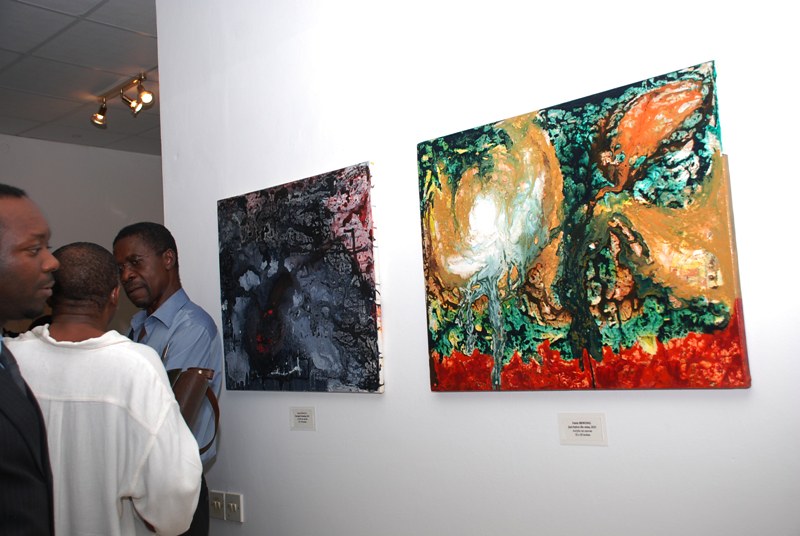
“An Exhibition Exploring the Presence of Absence”

“Earthshaker”: Confronting Absence, Memory, and Resistance through Ana Mendieta, Derek Jarman, and P. Staff
By blending physical sensation, poetic dissonance, and visceral materiality, the exhibition Earthshaker — currently on view at Del Vaz Projects in Santa Monica through April 18 — presents a layered meditation on the political and emotional resonances of the body. Featuring the work of Ana Mendieta, Derek Jarman, and P. Staff, the group show spills across two rooms, offering a spectrum of mediums and provocations that render visibility to invisible forces: trauma, loss, resistance, and identity.
Contextualized in a serene outdoor courtyard, the show begins with a jarring transition — from the golden Southern California sun into the sensory-challenging darkness of P. Staff’s In Ektase (2023), a five-channel video installation. Using rotating LED fans to broadcast hallucinogenic visuals and fragmented verse, Staff plunges viewers into a dysphoric experience, where strobing lights and pulsating audio simulate the breakdown of cohesion between body and environment. The phrases flashed across fragmented holograms — “descend slowly deeper into hell w/ velocity” — point to the violence experienced by queer and trans people navigating hostile political and societal systems. The viewers’ discomfort becomes a part of the work’s efficacy, transforming spectatorship into shared embodiment of instability.
The disorientation evoked by Staff finds echo — albeit in gentler form — in the adjacent room dedicated to Ana Mendieta, whose artworks conjure memories painted not in presence, but in absence. Her famed Silueta Series (1973–1980) is represented by four haunting photographs and a short Super 8 film. Each image captures a figure outlined in natural materials — moss, stone, vines — as if the earth itself remembers a person no longer there. Mendieta’s artistic practice centered Indigenous and feminine cosmologies, deeply exploring themes of displacement, identity, and mortality. In a film depicting a silhouette outlined with gunpowder slowly burning away, smoke replaces human form, evoking rituals of both destruction and transcendence.
What makes Mendieta’s work timelessly chilling is its spectral subtlety — the suggestion that violence and memory are imprinted lightly, yet irrevocably, into landscape, and thus into our psyche. The resilience of her images lies in their refusal to disappear; they haunt rather than scream, illuminating feminist and diasporic pasts.
In striking contrast to these luminal imprints are the obdurate assemblage paintings of Derek Jarman. Best known for his avant-garde filmmaking and AIDS activism, Jarman’s mixed media canvases in Earthshaker are dense, dark, and heavy — physical manifestations of grief and coded protest. Layering found objects onto bubbling tar and primed lead surfaces, he creates relics embedded with pain and sacredness. Rusted nails, shattered glass, spent bullet casings and wedding rings are relics of mourning as much as making — embodying a post-AIDS-crisis introspection where surviving meant carrying the weight of no longer-forgotten lives.
Jarman’s canvases are not just textural treatises on death; they are rebuttals to erasure. He transforms detritus into icons, layering meaning into the very process of creation — making trauma visible, embedded, permanent.
Collectively, the three artists in Earthshaker shift the viewer’s attention from figuration to the spaces around and between bodies — liminal zones where affect, identity, and memory live. By doing so, they question the norms of representation. What does it mean to be seen, or to vanish? What is the shape of grief when abstracted from narrative? What new forms of resistance can emerge when we embrace fragmentation instead of wholeness?
These questions reverberate across the quiet power of the works — from burned silhouettes, broken artifacts, to flickering affirmations like “I AM ALIVE / YOU ARE DEAD.” Staff, Mendieta, and Jarman do not offer easy answers. Instead, they craft invitations to dwell in ambiguity, where recognition and rupture coexist. Their art trembles — it quakes — and in that trembling lies the power to remake, reimagine.
Earthshaker not only addresses the violence done to bodies, but also the tremors of resilience that rise from those shadows. It’s an exhibition that both mourns the past and gestures toward new futures. As Audre Lorde once invoked the regenerative energy of planarians — creatures with the ability to regrow severed parts — so too do these artists map the wounds of history while sending out pulses of creative regeneration.
Earthshaker: Ana Mendieta, Derek Jarman, and P. Staff continues at Del Vaz Projects (259 19th Street, Santa Monica, California) through April 18. It is a quietly thunderous collection — where loss becomes the raw material from which we might dream worlds